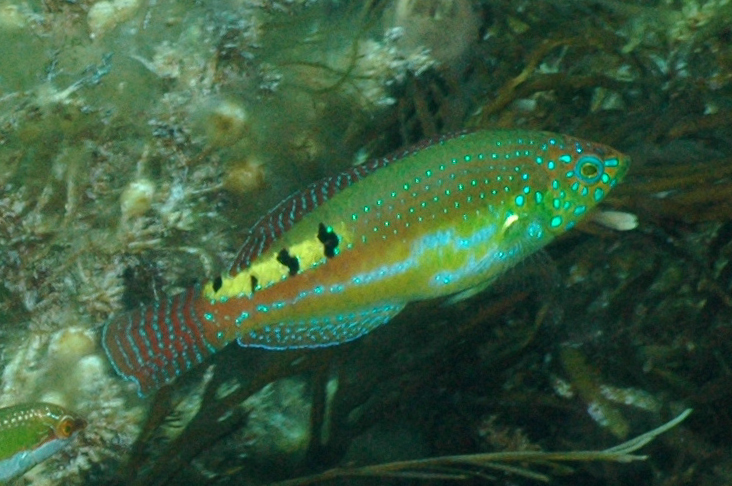Little Rainbow Wrasse, Dotalabrus alleni Russell 1988

A male Little Rainbow Wrasse, Dotalabrus alleni. Source: Graham Edgar / Reef Life Survey. License: CC BY Attribution-Noncommercial
A small variably coloured wrasse. Juveniles and females (initial phase) are greenish-yellow to dark green with five irregular black bars on the posterior sides, blue markings around the eye and a black spot or ocellus at the rear of the dorsal- and anal-fin bases. Males are reddish-yellow, gold or dark green with four black blotches in a broad yellow streak on the upper rear sides, torquoise markings radiating from the eyes and pale pelvic fins.
Little Rainbow Wrasse, Dotalabrus alleni Russell 1988
More Info
|
Distribution |
Endemic to south Western Australia, from the Recherche Archipelago to the Houtman Abrolhos islands. Mostly inhabits shallow rocky reefs at depths to 15 m, especially in offshore waters. |
|
Features |
Dorsal fin IX, ll (rarely IX, l0); Anal fin III,10 (rarely III, ll); Caudal fin 5 + 2 + 12 + 2+5 (5-6 [rarely 3] + 2 + 12 + 5-5 [rarely 4]); Pectoral fin ii, 10; Pelvic fin 1,5; Gill rakers (first arch)18 (15-19). Lateral line scales 25 (25-26); scale rows above lateral line 3; scale rows below lateral line 9 (8-9); predorsal scales 4 (4-6); cheek scale rows behind eye 1; cheek scale rows below eye 2 (1-2). |
|
Size |
A small species: males reaching 8.5 cm SL (males 56.6-84.5 mm SL); females to 8.1 cm SL. |
|
Colour |
The species is sexually dichromatic. Initial phase (juveniles and females) greenish-yellow to dark green with 5 irregular black bars on posterior sides; blue markings radiating from eyes; a black spot on the rear of the dorsal- and anal-fin bases; clear pelvic fins. Terminal phase (males) reddish-yellow, gold or dark green, with 4 black diamond-shaped markings interspersed with yellow on the back before the tail; a pearly band along the sides below the body midline; caudal fin with 5-6 narrow reddish bars; pelvic fins pale yellowish. |
|
Feeding |
Thought to be fairly generalised carnivores with well-developed canines in the jaws and robust pharyngeal teeth. The anterior canines are forwardly curved, the anterior teeth in the upper and lower jaws are enlarged, recurved canines. |
|
Biology |
A protogynous hermaphrodite - changes sex from female to male during the life cycle. |
|
Fisheries |
Of no interest to fisheries. |
|
Remarks |
Like most wrasses, the Little Rainbow Wrasse is territorial or has a home range. It is active during the day and seeks shelter at night by burying in the sand. |
|
Similar Species |
Differs from Castelnau's Wrasse, Dotalabrus aurantiacus, only other species in the genus, in terminal phase (male) coloration, and in having clear pelvic fins and a moderately short dorsal fin spine (vs greyish pelvic fins and a moderately long first dorsal-fin spine). Although both species are found in Western Australia, D. alleni mainly inhabits rocky reefs, whereas D. aurantiacus usually occurs in seagrass beds. |
|
Etymology |
The species is named for Dr. Gerald R. AlIen who collected the holotype and several paratypes, and drew the author's attention to this new species. |
|
Species Citation |
Dotalabrus alleni Russell 1988, Rec. Aust. Mus. Suppl. 9: 10, Figs. 2,12-13,15-18,23; Pl. 1(c-d). Type locality: off Carnac Island, Cockburn Sound, 36°16'S, 115°40'E, Western Australia, depth 8 m. |
|
Author |
Bray, D.J. 2022 |
|
Resources |
Little Rainbow Wrasse, Dotalabrus alleni Russell 1988
References
Choat, J.H., Pollard, D., Russell, B. & Sadovy, Y.J. 2010. Dotalabrus alleni. The IUCN Red List of Threatened Species 2010: e.T154841A4647878. http://dx.doi.org/10.2305/IUCN.UK.2010-4.RLTS.T154841A4647878.en. Downloaded on 18 October 2018.
Edgar, G.J. 2008. Australian Marine Life: the plants and animals of temperate waters. Sydney : Reed New Holland 2nd edn, 624 pp.
Gomon, M.F. &. Russell, B.C. 1994. Family Labridae. pp. 675-699 in Gomon, M.F., Glover, C.J.M. & Kuiter, R.H (eds). The Fishes of Australia's South Coast. Adelaide : State Printer 992 pp. 810 figs
Hoschke, A., Whisson, G. & Moore, G.I. 2019. Complete list of fishes from Rottnest Island. pp. 150-161 in Whisson, G. & Hoschke, A. (eds). The Rottnest Island fish book. 2nd ed. Perth, Western Australia : Aqua Research and Monitoring Services.
Hutchins, J.B. 2001. Biodiversity of shallow reef fish assemblages in Western Australia using a rapid censusing technique. Records of the Western Australian Museum 20: 247-270.
Hutchins, J.B. 2005. Checklist of marine fishes of Recherche Archipelago and adjacent mainland waters. pp. 425-449 in Wells, F.E., Walker, D.I. & Kendrick, G.A. (eds). Proceedings of the Twelfth International Marine Biological Workshop: The Marine Flora and Fauna of Esperance, Western Australia. Perth : Western Australian Museum.
Kuiter, R.H. 2002. Fairy & Rainbow Wrasses and their Relatives. Chorleywood, U.K. : TMC Publishing 207 pp.
Kuiter, R.H. 2010. Labridae fishes: wrasses. Seaford, Victoria, Australia : Aquatic Photographics pp. 398.
Russell, B.C. 1988. Revision of the labrid fish genus Pseudolabrus and allied genera. Records of the Australian Museum Suppl. 9: 1-72, plus addendum after plates., col. Pls. 1-4. https://doi.org/10.3853/j.0812-7387.9.1988.95
Russell, B.C. & Gomon, M.F. 2008. Family Labridae. pp. 638-659 in Gomon. M.F., Bray, D.J. & Kuiter, R.H (eds). Fishes of Australia's Southern Coast. Sydney : Reed New Holland 928 pp.





